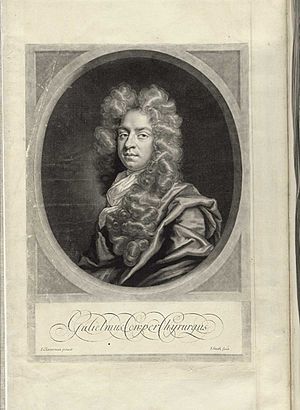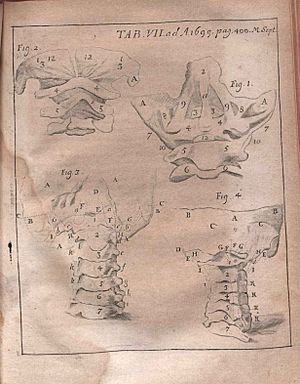William Cowper (anatomist) facts for kids

William Cowper (born around 1666 – died 8 March 1709) was an English surgeon and anatomist. He is famous for describing a small gland in the human body. Today, this gland is known as Cowper's gland.
Contents
Early Life and Career
William Cowper was born in Petersfield, Hampshire, England. Around 1682, he started training to become a surgeon in London. His teacher was a surgeon named William Bignall.
In 1691, Cowper became a member of the Company of Barber-Surgeons. This allowed him to practice surgery in London. He quickly became known for his skills.
Important Publications
In 1694, Cowper published his first important book. It was called Myotomia Reformata, or a New Administration of the Muscles. This book was about the human muscles.
Because of his work, he was chosen to be a member of the Royal Society in 1696. This is a very old and respected group for scientists.
His most famous book came out in 1698. It was titled The Anatomy of the Humane Bodies. This book made him very well-known. Over the next eleven years, he wrote many more papers. These papers covered topics like surgery, how diseases work, how the body functions, and human anatomy.
William Cowper died on 8 March 1709. He was buried in his hometown of Petersfield.
The Anatomy of the Humane Bodies Controversy
Cowper's famous book, The Anatomy of the Humane Bodies, caused some arguments. Some people said it was a major case of plagiarism. Plagiarism means using someone else's work without giving them credit.
The Original Plates
In 1685, a Dutch anatomist named Govard Bidloo published his own book. It was called Anatomia Humani Corporis. This book had 105 beautiful pictures. These pictures were drawn by Gérard de Lairesse and engraved by Abraham Blooteling.
Later, a Dutch version of Bidloo's book was printed. But it did not sell well. So, Bidloo's publishers sold 300 copies of the pictures. These pictures were bought by William Cowper or his publishers.
Cowper's Contribution
Cowper then wrote new English text to go with these pictures. He also added nine new pictures of his own. These new pictures were drawn by Henry Cooke. They were engraved by Michiel van der Gucht. Some of these new pictures showed the full human muscles from the front and back.
When Cowper's book was published, it had his name on it. It did not mention Bidloo or Lairesse. The original title page was changed to fit the new English title.
The Dispute
Because of this, Bidloo and Cowper had a big disagreement. They both published papers defending themselves. Cowper claimed that the pictures were not Bidloo's in the first place. He said they belonged to another scientist, Jan Swammerdam. Cowper claimed Swammerdam's widow sold them to Bidloo after Swammerdam died.
It is clear that William Cowper was a very skilled anatomist and surgeon. However, he did not properly credit Govard Bidloo for the pictures used in his famous book.


